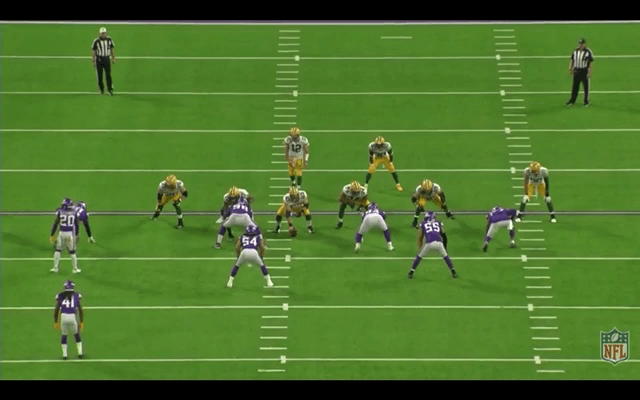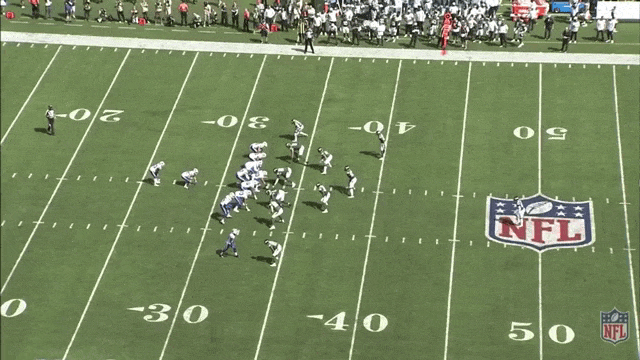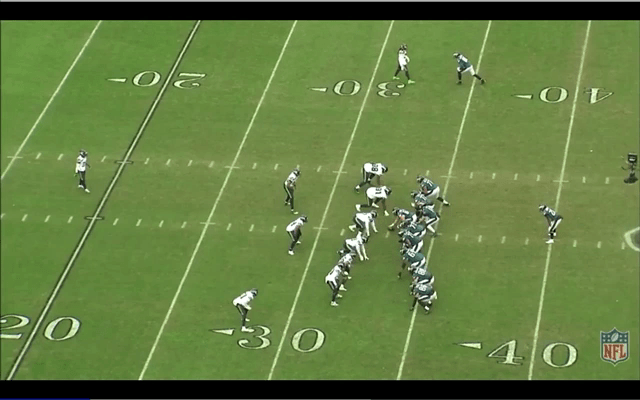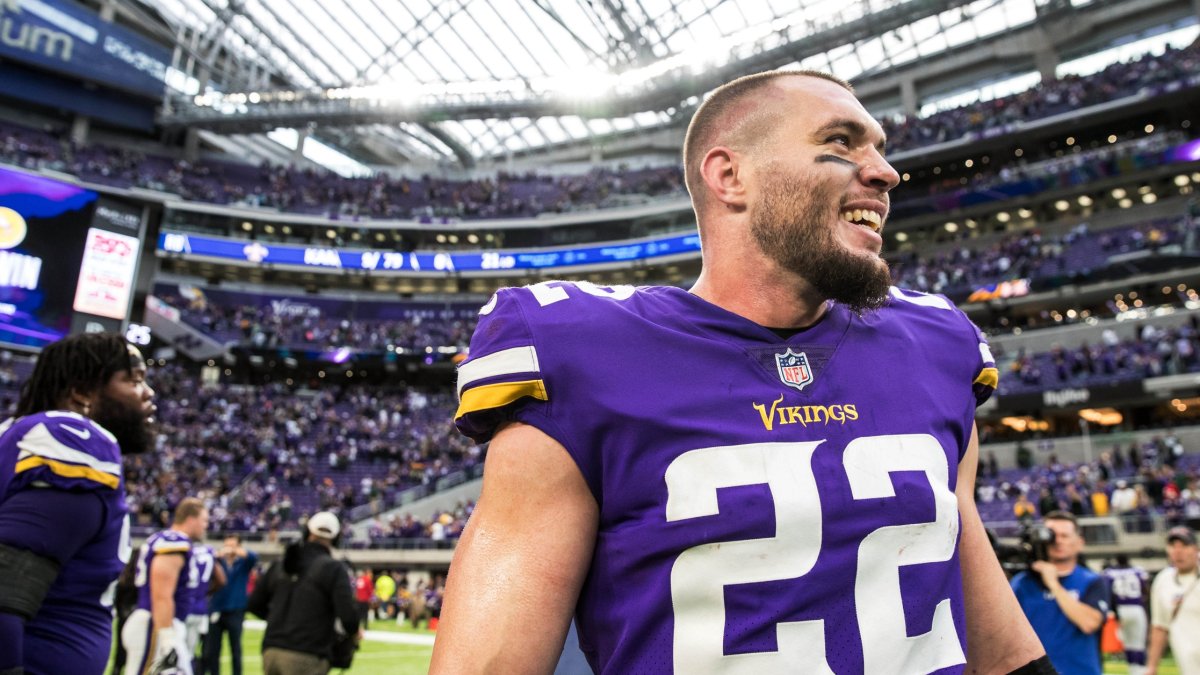The value of versatile, three-down safeties is at an all-time high in today's NFL. With the ever-growing use of creative passing concepts, defensive coordinators throughout the league have come to rely on athletic safeties to disrupt the passing game, either by combating athletic tight ends or facing up against big-bodied receivers in the slot.
In this article, we look at the most stable metrics for safeties in both man and zone coverage and examine the unique ways each player performs within their team's coverage scheme. Here are the best safety tandems in the NFL right now.
[Editor's note: Subscribe to PFF ELITE today to gain access to PFF's Premium Stats and new Player Grades experience in addition to the 2020 NFL Draft Guide, 2020 Fantasy Rookie Scouting Report, PFF Greenline, all of PFF's premium article content and more.]
1. Harrison Smith & Anthony Harris, Minnesota Vikings
No pair of safeties has performed better or lifted their defense higher than the Vikings' tandem of Harris and Smith. A season ago, Harris (91.6) and Smith (91.4) produced PFF's top two coverage grades among players at the position. Harris also finished second at the position in terms of PFF's wins above replacement (PFF WAR) metric, while Smith finished fourth.
The formidable duo leads a secondary that relies on a variety of zone concepts that hand their safeties the responsibility of closing off the middle of the field. Since 2018, the Vikings have played quarters coverage more than any other coverage shell, lining up in that look on 16.1% of their defensive snaps.

This coverage scheme is more nuanced than your basic zone coverage, and it can resemble variable looks from one side of the field to the other. Harris is used as a primary deep-middle defender where his elite ball skills and closing range is greater than the veteran Smith, who can leverage his instincts and experience to disguise his alignment and assignment.
The struggle has been real for opposing quarterbacks. The Vikings safeties have allowed a combined 67 receptions from 110 targets in primary coverage over the past two seasons, giving up just 797 yards in the process. More impressive, however, is the fact that they've surrendered only two touchdowns while coming away with 17 interceptions over that timeframe — two more interceptions than the league's next closest safety group.
Minnesota Vikings Safeties: Combined coverage stats from 2018-19 (regular season only)
| Stat | Rank | |
| Coverage grade | 96.9 | 1st |
| Man-coverage grade | 85.5 | 5th |
| Zone-coverage grade | 94.8 | 1st |
| Coverage grade on plays with no pressure | 94.1 | 1st |
| Coverage grade on passes thrown in 3 seconds or less | 94.7 | 2nd |
| Forced incompletion percentage | 18.2% | 1st |
| Passer rating allowed | 49.5 | 1st |
2. Devin McCourty & Patrick Chung, New England Patriots
No team called a higher percentage of Cover 0 and Cover 1 (51.8%) than the New England Patriots a season ago. It's a coverage scheme that places a tremendous burden on safeties Devin McCourty and Patrick Chung to both communicate and eliminate their opponent's biggest threat.
McCourty and Chung are responsible for coordinating Belichick's plans to disguise their coverages with complex pre-snap alignments that require precision and well-timed movements. It is a high-risk, high-reward approach to pass coverage, but it helped the Patriots become the only team in the league to collect more interceptions (25) than touchdown passes allowed (13) last season.
The safety duo is a huge reason why New England ended the 2019 campaign with PFF's highest team coverage grade (92.7). McCourty and Chung allowed a combined 50 receptions and two touchdowns from 74 targets, and opposing quarterbacks managed a passer rating of just 65.0 on throws into their primary coverage.
McCourty, who headlines the duo, finished last season with an 89.1 coverage grade that ranked sixth among the 68 qualifying safeties who played at least 300 coverage snaps. His man coverage grade of 80.7 over the last two seasons ranks 10th out of 31 qualifiers. He has been the epitome of consistency and high-level performance over the last 10 seasons in the Patriots secondary.
3. Micah Hyde & Jordan Poyer, Buffalo Bills
When head coach Sean McDermott first arrived in Buffalo three years ago, he set out to build his defense around safeties Micah Hyde and Jordan Poyer, who helped turn the Bills secondary into one of the league's best coverage units.
Buffalo Bills Safeties: Combined coverage stats from 2018-19 (regular season only)
| Stat | Rank | |
| Coverage grade | 94.9 | 2nd |
| Man-coverage grade | 84.8 | 10th |
| Zone-coverage grade | 95.7 | 2nd |
| Coverage grade on plays with no pressure | 95 | 3rd |
| Coverage grade on passes thrown in 3 seconds or less | 94.9 | 4th |
| Forced incompletion percentage | 13.0% | 12th |
| Passer rating allowed | 93.1 | 15th |
Over the last two seasons, Hyde has earned the fourth-best man-coverage grade (85.0) among qualifying safeties while Jordan Poyer has earned the eighth-best zone-coverage grade (86.1). Their collaboration has helped the Bills' pass defense allow the fewest yards per reception (9.8) over the last two seasons. McDermott's formula has worked in Buffalo, and his key ingredients begin with Hyde and Poyer.
4. Jamal Adams & Marcus Maye, New York Jets
It doesn't matter whether you measure it by PFF grade or PFF WAR, Jamal Adams is arguably the game's ultimate weapon from the safety position — he is a do-it-all safety who routinely produces plays behind the line of scrimmage. Adams is the only safety in the NFL who played at least 200 snaps yet earned top-10 PFF grades in coverage, as a tackler, in the pass rush and overall.
Jamal Adams: grades and rank by facet in 2019 (regular season only)
| Facet | Rank | |
| PFF overall grade | 87.9 | 4th |
| PFF coverage grade | 87.3 | 7th |
| PFF run-defense grade | 78.3 | 12th |
| PFF Tackling grade | 90.0 | 2nd |
| PFF pass-rush grade | 89.9 | 2nd |
Adams has even garnered the ninth-best man-coverage grade (81.9) over the last two seasons, and he has often overshadowed the stellar play of his fellow safety, Marcus Maye.
Like Adams, Maye has also graded above 70.0 in each of the last two seasons, and his 77.4 coverage grade in 2019 was good enough to rank 23rd among 100 qualifying safeties.

Maye's 30.0% forced incompletion percentage last season tied Harrison Smith for fourth-best among qualifying safeties, while his 45.0% completion percentage allowed was second to only Earl Thomas III (38.5%). If Adams decides to remain in New York, he and Marcus Maye will continue to turn heads as one of the best safety pairings in the game.
5. Ha Ha Clinton-Dix & Xavier Woods, Dallas Cowboys
Both Clinton-Dix and Woods have earned top-20 coverage grades over the last two seasons, combining for a total of 34 turnovers during their brief NFL careers.
Both safeties have proven to be more than efficient when featured in a man-coverage scheme. Over the last two years, Clinton-Dix has the second-highest man-coverage grade (87.8) among the 31 qualifying safeties over that period, while Woods (70.2) ranks 17th. Together, they've allowed only 19 receptions from 31 targets in man coverage, giving up only 151 yards and a touchdown while coming away with six combined interceptions.
Clinton-Dix's recent production has been somewhat overshadowed by his frequent moves and the lack of a long-term contract. But with a second-ranked man coverage grade (88.6) while aligned in the box and a 10th-ranked run-defense grade (79.7) when aligned as a slot-defender, Clinton-Dix has proved to be as versatile as any safety in the game.
6. Malcolm Jenkins & Marcus Williams, New Orleans Saints
As a true centerfield safety, Marcus Williams earned the fifth-highest coverage grade (89.2) among the 68 players at his position who played at least 300 coverage snaps last season. A former track star who possesses excellent range, Williams recorded 10 total plays on the ball in 2019 — six pass breakups and four interceptions — and allowed a passer rating of only 47.8 on throws into his coverage.
The fourth-year safety is set to be joined by 11-year veteran Malcolm Jenkins, who spent five seasons with the Saints from 2009-13.
Jenkins earned a 67.5 coverage grade in 2019, his lowest single-season grade since his last year with the Saints in 2013, but his man-coverage grade of 78.5 ranked fourth among the 10 safeties who played 100 or more man-coverage snaps from the slot.
Since 2018, Jenkins (82.4, 19th) and Williams (89.9, 11th) have earned top-20 coverage grades because of their consistency and reliability. Both players could help rid the Saints of their late-game miscues and solidify what could be a championship defense.
7. Earl Thomas III & Chuck Clark, Baltimore Ravens
Earl Thomas finished the 2019 NFL campaign with the eighth-best coverage grade (84.7) among qualifying safeties, just one spot ahead of backfield mate Chuck Clark (81.9), who ranked ninth overall.
With Thomas and Clark as their safety tandem, the Ravens lined up in either Cover 1 or Cover 0 on 45.5% of their 979 total defensive snaps. Thomas aligned as the single-high safety in Cover 1, ending the regular season having allowed a passer rating of just 21.5 on throws into his primary coverage. This left Clark to rotate down into the box or the slot, where he earned the best coverage grade among safeties who played at least 100 such snaps.
Clark, who has just recently signed a three-year extension with the team, allowed 16 receptions from 19 targets in the box or the slot, but those catches only went for 94 yards. His 5.9 yards allowed per reception from such alignments ranked second among qualifying safeties, and only two of the catches he allowed went for a first down.
8. Justin Simmons & Kareem Jackson, Denver Broncos
Simmons (91.0, third) and Jackson (79.8, 13th) both earned coverage grades that ranked among the top 15 qualifying players at their position in 2019.
Simmons, the most valuable safety in the NFL last season per PFF WAR, proved to be an extremely versatile asset for Vic Fangio in his first year in Denver. The fourth-year safety graded above 85.0 as a run defender, as a tackler and in coverage, and he ended the season having allowed a passer rating of just 32.1 on throws into his coverage — second to only Earl Thomas in 2019.
Jackson played his previous eight seasons at cornerback in Houston but transitioned to safety after joining the Broncos' secondary — and he thrived. The veteran ended up earning the second-best PFF overall grade of his career and even finished second — to Justin Simmons, as it happens — among safeties in pass breakups, with nine.
9. Quandre Diggs & Bradley McDougald, Seattle Seahawks
After four seasons with the Detroit Lions, Diggs joined the Seattle Seahawks last year in a midseason trade and provided an immediate return upon his arrival.
The fifth-year safety out of Texas earned a 79.3 coverage grade, 14th among safeties who played 300 or more snaps. He was targeted only eight times in primary coverage but still came away with three interceptions, ending the season with a 32.3 passer rating allowed.

Meanwhile, his partner, Bradley McDougald, has sneakily been one of the best man-coverage safeties in the entire league over the last two seasons. Since 2018, McDougald's 85.4 man-coverage grade ranks fourth among the 104 safeties who have played at least 100 snaps of man coverage over that span, while his 62.7 passer rating allowed in man coverage ranks fifth among those who were targeted at least 20 times.
As the Seahawks look to rebuild the Legion of Boom 2.0, both Diggs and McDougald will serve as foundational pieces to support their new secondary. And after finishing with a 15th-ranked 75.0 team coverage grade in 2019, a top-10 finish in 2020 is not out of the question.
10. Tyrann Mathieu & Juan Thornhill, Kansas City Chiefs
While on the way to helping the Kansas City Chiefs win their first Super Bowl title in franchise history, safeties Tyrann Mathieu (81.6, 10th) and rookie Juan Thornhill (78.0, 17th) earned top-20 coverage grades during the 2019 regular season.
After starting all 16 regular-season games, an ACL injury sidelined Thornhill for the entire postseason. However, he still managed to allow just 14 catches from 25 targets during his time on the field, giving up only 147 yards and a passer rating of 69.9 in the process.
Over the last two seasons, Tyrann Mathieu's 85.8 coverage grade ranks 17th among the 103 safeties who played 300 or more coverage snaps over that span. And when featured in the more difficult single-man coverage assignments, Mathieu graded among the top 25 qualifying players at his position.
Tyrann Mathieu: Performance in man coverage, 2018-19 (regular season only)
| Stat | Rank | |
| Man-coverage snaps | 453 | 7th |
| Coverage grade | 77.1 | 21st |
| Coverage grade on plays with no pressure | 72.5 | 25th |
| Coverage grade on passes thrown in 3 seconds or less | 75.5 | 25th |
| Coverage grade while lined up in the box | 73.8 | 3rd |
| Coverage grade while lined up in the slot | 75.6 | 5th |
Mathieu has now graded above 70.0 in each of his last three seasons, and he even allowed a career-low 67.5 passer rating on throws into his coverage despite being targeted 76 times over the course of the regular season.
Together with the promising rookie, Mathieu will be looking to lead the Chiefs' secondary to a top-10 finish in 2020 after ranking 18th in team coverage grade in 2019.



 © 2025 PFF - all rights reserved.
© 2025 PFF - all rights reserved.